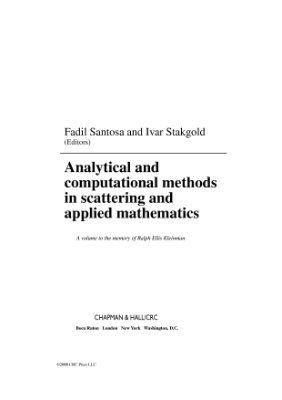Chapman and Hall/CRC, 2000. - 288 Pages.
Most of the papers in this collection were presented at the Inteational Conference in Applied Mathematics, held in memory of Ralph Ellis Kleinman in November 1998 at the University of Delaware. Additional papers were solicited from colleagues of Ralph's.
Ralph Kleinman was an eminent researcher in wave propagation, scattering theory, and inverse problems. At the time of his death in February 1998, he was UNIDEL Professor of Mathematical Sciences and the Director of the Center for the Mathematics of Waves at the University of Delaware. Motivated by physical problems - whether in acoustics, electromagnetic theory, or continuum mechanics - he used rigorous mathematical analysis to obtain results of considerable interest to the larger engineering community. He was particularly adept at applying techniques from analysis to answer questions of computational accuracy, and to design effective computational methods. He had a remarkable ability to communicate with scientists and engineers not trained in mathematics. Indeed, he was a community builder who created research activities around application areas rather than disciplines. It was not a surprise to anyone when he was elected Fellow of IEEE in 1994.
Most of the papers in this collection were presented at the Inteational Conference in Applied Mathematics, held in memory of Ralph Ellis Kleinman in November 1998 at the University of Delaware. Additional papers were solicited from colleagues of Ralph's.
Ralph Kleinman was an eminent researcher in wave propagation, scattering theory, and inverse problems. At the time of his death in February 1998, he was UNIDEL Professor of Mathematical Sciences and the Director of the Center for the Mathematics of Waves at the University of Delaware. Motivated by physical problems - whether in acoustics, electromagnetic theory, or continuum mechanics - he used rigorous mathematical analysis to obtain results of considerable interest to the larger engineering community. He was particularly adept at applying techniques from analysis to answer questions of computational accuracy, and to design effective computational methods. He had a remarkable ability to communicate with scientists and engineers not trained in mathematics. Indeed, he was a community builder who created research activities around application areas rather than disciplines. It was not a surprise to anyone when he was elected Fellow of IEEE in 1994.

